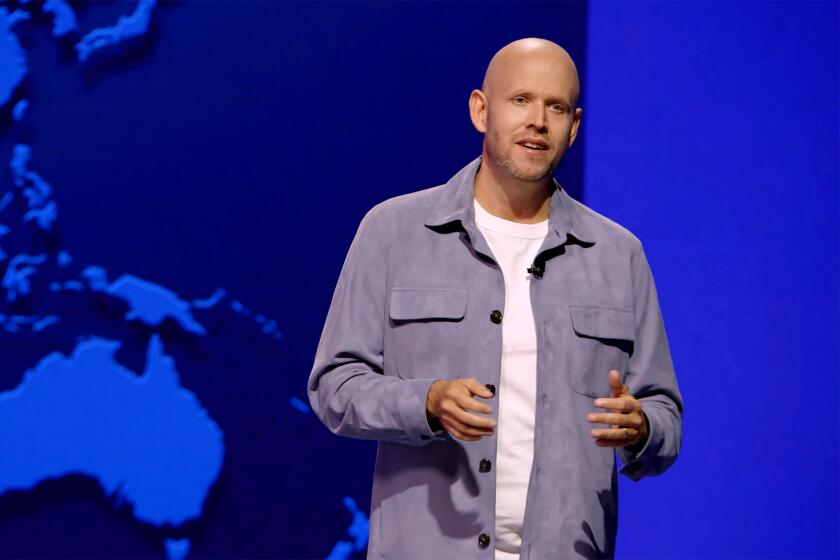Hootchy-kootchy roles or nothing? The state of Hollywood diversity
When Spike Jonze’s movie “Her” came out last year, it was buzzed about for its dystopic take on a society where people have affairs with their phones and its vision of a near-future L.A. where you could take Metro to the beach.
But “Her” left me feeling unsettled, and it had nothing to do with those horrible high-waisted pants Joaquin Phoenix wore. For Jonze made a movie about a future L.A. comprised almost exclusively of white people. Sure, there were some minorities wafting spectrally through the background, but that was about it. Throughout the film, and after, I was filled with the urge to shout at the screen, WHAT HAVE YOU DONE WITH ALL THE MEXICANS?
Decorum and the bucket of popcorn in my lap prevented me from doing so. But it’s worth noting that I wasn’t the only one to notice. According to the latest Census data, L.A. is currently 48.5% Latino, part of a growing list of American cities that are majority minority. So how could a movie that envisions our city’s near-future pretty much leave Latinos, and other underrepresented minority groups, completely out of the picture?
------------
FOR THE RECORD
A statistic featured in this post incorrectly reported that there had been no black female directors in charge of the top grossing Hollywood films in the period between 2007-2013. There were, in fact, two black female directors on that list in 2008: Gina Prince-Bythewood and Sanaa Hamri. For the other years in question, however — 2007 and 2009-2013 — no black female film directors helmed a top-grossing Hollywood picture.
------------
It’s a phenomenon that is hardly specific to Jonze. On Tuesday, the Media, Diversity & Social Change Initiative at USC released its annual report on diversity in the 100 top-grossing films of 2013. The numbers do not paint a pretty picture: Latinos remain sorely underrepresented, black women have presided over a Hollywood blockbuster only twice in the seven years the study has been conducted, and Latinas are the most disproportionately sexualized of the bunch. Like, hootchy-kootchy levels of disproportionately.
USC professor Stacy Smith, who wrote the study and leads the team that compiled the findings, told my colleague Amy Kaufman that “2013 was not a banner year — it was business as usual.”
Anyone who goes to the movies could probably tell you, “Well, duh.” But it’s nice to have facts, since these invariably tell a far more interesting story.
Certainly, it is no big surprise that whites over-index in speaking roles. According to the USC study, they account for 74.1% of them, even though non-Hispanic whites comprise only 62.6% of the U.S. population.
Other ethnicities are roughly on par with their populations. Of the 3,923 speaking roles featured in the top-grossing films of 2013, African Americans account for 14.1%, while representing 13.2% of the U.S. population. A pretty good number, though it’s hard to know what this translates to as far as screen time, since the study counts a “speaking role” as one in which a single word or a thousand is said. Asians are at roughly the same levels, with their speaking roles landing within a percentage point of their population.
It’s Latinos who fare the worst. Despite representing 17.1% of the U.S. population, they account for only 4.9% of all speaking roles.
At the same time, Latinos over-index in sexualized portrayals — that is, scenes where they are depicted in sexy attire or showing some skin. African American and Asian women also over-index in this category. But Latinas are by far the most represented, with more than 37% of the Latina characters in the top-grossing flicks of 2013 shown either partially nude or fully naked. On top of that, more than 36% of Latina characters are shown in sexualized attire, including, tight or revealing clothing.
Chon Noriega, a professor of cinema and media studies at UCLA, says this discrepancy — between the general lack of representation and the over-indexing on sexualized portrayals — is worth exploring.
“By a factor of almost 4 to 1, we are underrpresented,” he says. “But then, when we’re represented, it’s with our clothes off. I think it reveals a real ambivalence about the Latino population in this country. It’s almost like they’re saying, ‘We know you are here, and immigration is causing some big problems in terms of coping about what our country really is, but if we’re going to have you up there, we’ve got some fantasies to work out.’
“What’s interesting is that this is happening both ways — to men and women,” says Noriega, who also serves as the director of UCLA’s Chicano Studies Research Center. “Obviously, it happens to a higher degree to women because our culture eroticizes women more. But, in effect, it’s a depiction that turns us into an object.”
Latino men, it turns out, show off skin 16.5% of the time, the highest rate of any of the ethnic groups present. This is followed by Asian men, who are shown nude or partially nude 15.4% of the time.
Why some of this is happening is beyond the scope of the study, which is purely about numbers. But if USC was thinking of doing a narrower follow-up, I’d love to suggest that it hone in on this detail. What is the context of these sexualized scenes? Are they significant to the plot? And how often do they entail violence? Can you break all of that down by gender and race?
Also of note in the study: Animated films are the worst when it comes to the under-representation of minority groups on the big screen.
The most disconcerting aspect to all of this is that many of the figures in the study have remained pretty flat over the last seven years. In 2007, Latinos represented 3.3% of all speaking roles. In 2010, they got 4.9%. Seven years ago, Asians had 3.4% of speaking roles; today, it’s 4.4% (a dip from 2008, when they had 7.1%). Likewise, African Americans saw their representation grow about a percent (with dips in intervening years).
Black directors were more likely to put black characters into their movies. And, in an example of Hollywood bucking a larger societal stereotype, black males were the most likely to be shown in a committed relationship.
Still, why do the numbers in all these studies seem to stay essentially the same, even in a year when the best picture Oscar went to a film from a black director?
“Certainly, there are all the obvious reasons about who is in charge,” says Noriega. “But the industry is also a conservative business. It’s very conservative about how it understands the issue of taking risks and making money, of trying something new. The strange thing is that it’s conservative not because the formula works. The vast majority of films do not make a profit. So you’d think someone would say, ‘You know, maybe there’s a better way of doing this.’”
I can only hope that that person is now being hired by a major studio — or better yet, by USC’s powerful film school.
You can find the complete study, along with key findings, over at annenberg.usc.edu.
Find me on Twitter @cmonstah.
More to Read
The biggest entertainment stories
Get our big stories about Hollywood, film, television, music, arts, culture and more right in your inbox as soon as they publish.
You may occasionally receive promotional content from the Los Angeles Times.











